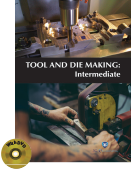Trade and Industrial Education

Tool and Die Making: Intermediate comprehends various diverse practical and visual skills with knowledge of specialized materials and techniques. Tool and die making is the industrial art of manufacturing stamping dies, plastics molds, and jigs and fixtures to be used in the mass production of solid objects.. This book will introduce the knowledge and skills for those studying and/or working in tool and die making industry to interpret and convey information in response to workplace requirements.
About this Book
The information in this book consists of basic, common and core competencies that a person must achieve to machine die components, fit and assemble dies and test and try die. A person who has achieved this qualification is competent to be: Tool Maker, Die maker, Machinist.
About the Tool and Die Making Industry
Tool and die makers are among the most highly skilled workers in manufacturing. These workers produce and repair tools, dies, and special guiding and holding devices that enable machines to manufacture a variety of products we use daily—from clothing and furniture to heavy equipment and parts for aircraft. Toolmakers craft precision tools and machines that are used to cut, shape, and form metal and other materials. They also produce jigs and fixtures—devices that hold metal while it is bored, stamped, or drilled—and gauges and other measuring devices. Die makers construct metal forms, called dies, that are used to shape metal in stamping and forging operations. They also make metal molds for die-casting and for molding plastics, ceramics, and composite materials. Some tool and die makers craft prototypes of parts, and then, working with engineers and designers, determine how best to manufacture the part. In addition to developing, designing, and producing new tools and dies, these workers also may repair worn or damaged tools, dies, gauges, jigs, and fixtures. To perform these functions, tool and die makers employ many types of machine tools and precision measuring instruments. They also must be familiar with the machining properties, such as hardness and heat tolerance, of a wide variety of common metals, alloys, plastics, ceramics, and other composite materials. Overall employment of machinists and tool and die makers is projected to grow 7 percent from 2012 to 2022, slower than the average for all occupations. Employment growth will vary by specialty. Employment of machinists is projected to grow 9 percent from 2012 to 2022, about as fast as the average for all occupations. Despite improvements in technologies, such as computer-numerically controlled (CNC) machine tools, autoloaders, high-speed machining, and lights-out manufacturing, machinists will still be required to set up, monitor, and maintain these automated systems. In addition, employers will continue to need machinists, who have a wide range of skills and are capable of performing modern production techniques, in a machine shop. Manufacturers will continue to rely heavily on skilled machinists, as they invest in new equipment, modify production techniques, and implement product design changes more rapidly.